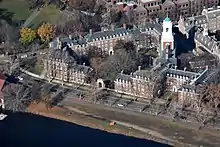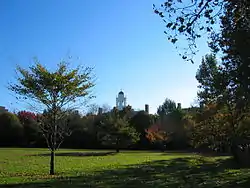| Eliot House | |
|---|---|
| Residential House | |
| Harvard University | |
 Eliot House on the Charles River | |
| Location | 101 Dunster Street, Cambridge, Massachusetts, U.S. |
| Coordinates | 42°22′13″N 71°07′15″W / 42.37022°N 71.12082°W |
| Established | 1930 |
| Named for | Charles William Eliot |
| Colours | Blue, Red, White |
| Sister college | Jonathan Edwards College and Emmanuel College |
| Faculty Deans | Kevin J. Madigan and Stephanie Paulsell |
| Dean | Andrea Wright |
| Undergraduates | 450 |
| Called | Eliotites |
| Website | eliot |
Eliot House is one of twelve undergraduate residential Houses at Harvard University. It is one of the seven original houses at the college. Opened in 1931, the house was named after Charles William Eliot, who served as president of the university for forty years (1869–1909).
Traditions
Before Harvard opted to use a lottery system to assign residences to upperclassmen (beginning with the class of 1999), Eliot was known as a 'prep' house, providing accommodation to the university's social elite, and being known as "more Harvard than Harvard". Describing Eliot House in the late 1950s and early 1960s, author Alston Chase wrote, "[A]lthough most Harvard houses in those days reflected the values of Boston Brahmin society ... Eliot was more extreme".
The motto 'Floreat Domus de Eliot' and 'Domus' are traditional chants and greetings, particularly on Housing Day, when freshman find out their housing assignments. Some traditions of Eliot House are the charity event An Evening with Champions, the Eliot Boat Club (an intramural crew team), formal dinners such as the Charles Eliot Dinner, a strong sense of house pride, and the annual Spring Fete.
Movie appearances

Eliot's prominent belltower is featured in many films, including Old School; Legally Blonde; Chasing Liberty; and Euro Trip, which features the tower at the end of the film, incorrectly identifying it as Oberlin College. Eliot House is also featured prominently in Love Story and The Social Network.
Notable alumni
Notable former residents of the house include:
- James Agee[1]
- Leonard Bernstein[2]
- Benazir Bhutto[3]
- Ben Bradlee[4]
- Archibald Cox[5]
- T.S. Eliot (as Charles Eliot Norton Chair of Poetry)[6]
- Patrick X. Gallagher[7]
- John Harbison[8]
- Rashida Jones[9]
- Eduardo Saverin[10]
- Ted Kaczynski[11]
- Jack Lemmon[12]
- Thomas Oliphant[13]
- George Plimpton[14]
- Jay Rockefeller[15]
References
- ↑ Eliot, Thomas Stearns (October 6, 1932). "Letter to Eleanor Hinkley, 6 October 1932". The Letters of T.S. Eliot, 1932-1933. Yale University. ISBN 9780300211801. Retrieved October 10, 2018.
- ↑ Fabry, Alexander B. (October 5, 2006). "Leonard Bernstein". The Harvard Crimson. Harvard University. Retrieved May 27, 2009.
- ↑ Lindsay, Jay (December 29, 2007). "Classmates recall Bhutto's intensity". USA Today. Retrieved May 27, 2009.
- ↑ Bradlee, Ben (1996). A Good Life. Simon & Schuster. p. 50. ISBN 0-684-82523-6.
- ↑ Gormley, Ken; Richardson, Elliot (1999). Archibald Cox: Conscience of a Nation. Da Capo Press. p. 23. ISBN 0-7382-0147-2.
- ↑ "ELIOT GIVES FIRST IN NORTON LECTURE GROUP". Harvard Crimson. 1932. Retrieved February 5, 2022.
- ↑ "Bound Brook Man Awarded Assistantship At Princeton". The Central Jersey Home News. June 17, 1956. p. 8. Retrieved December 28, 2019.
- ↑ "Composer Harbison To Receive 2000 Harvard Arts Medal". The Harvard University Gazette. March 9, 2000. Archived from the original on June 4, 2011. Retrieved June 3, 2009.
- ↑ "John Harvard's Journal, Commencement 1997". Harvard Magazine. Harvard University. Archived from the original on March 5, 2012. Retrieved January 23, 2010.
- ↑ "Harvard Alumni Directory". Harvard Alumni. Harvard University. Retrieved June 5, 2016.
- ↑ Pickover, Clifford A. (1999). Strange brains and genius: the secret lives of eccentric scientists and madmen. HarperCollins. p. 170. ISBN 0-688-16894-9.
- ↑ Pepp, Jessica A. (February 24, 1995). "Jack Lemmon to Receive Arts Medal". The Harvard Crimson. Harvard University. Retrieved January 23, 2010.
- ↑ Weisberg, Stuart E. (2009). Barney Frank: the story of America's only left-handed, gay, Jewish congressman. University of Massachusetts Press. p. 54. ISBN 978-1-55849-721-4.
thomas oliphant Eliot House.
- ↑ Aldrich, Nelson W. (2009). George, Being George: George Plimpton's Life as Told, Admired, Deplored, and Envied by 200 Friends, Relatives, Lovers, Acquaintances, Rivals--and a Few Unappreciative Observers. Random House. p. 61. ISBN 978-0-8129-7418-8.
- ↑ Solomon, Jason M. (March 5, 1992). "The World According to Kozol". The Harvard Crimson. Harvard University. Retrieved April 5, 2010.